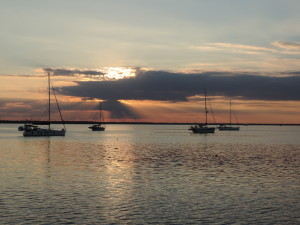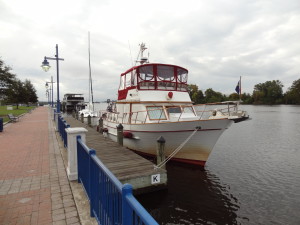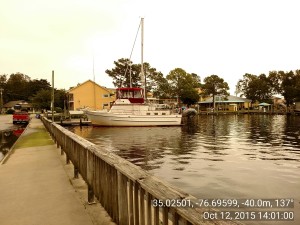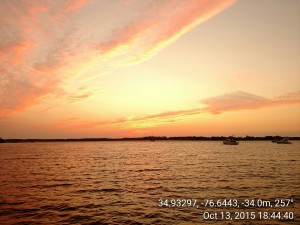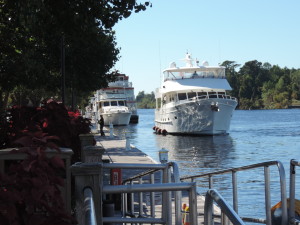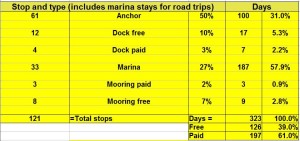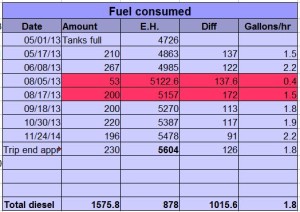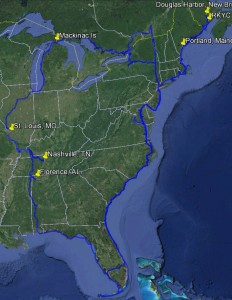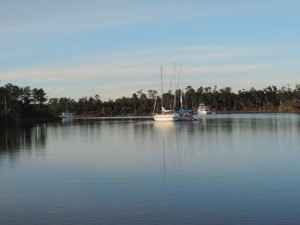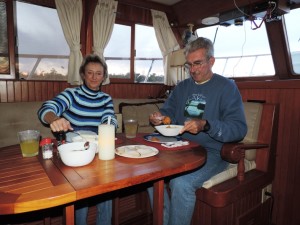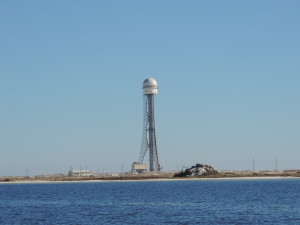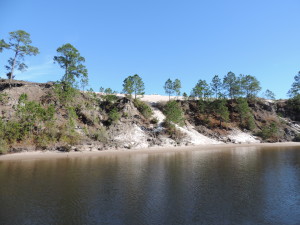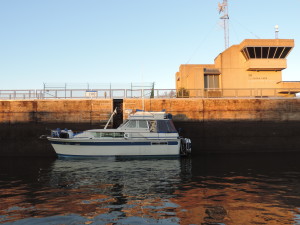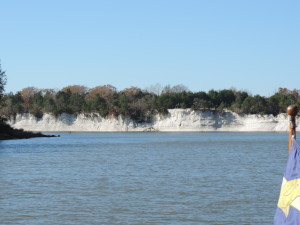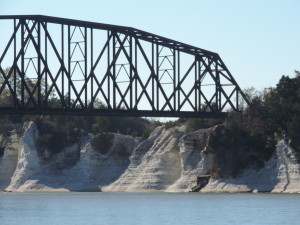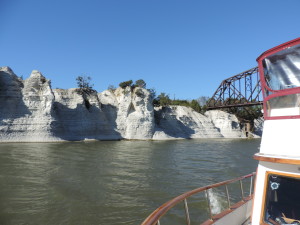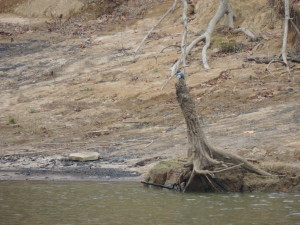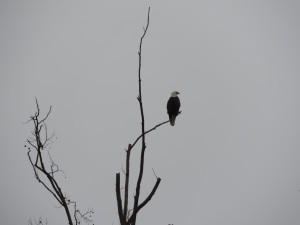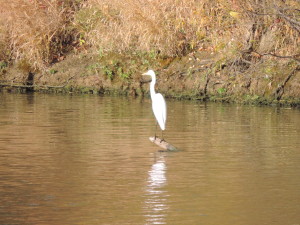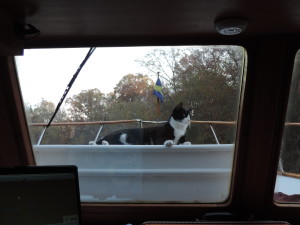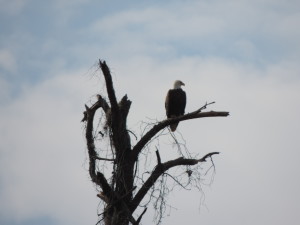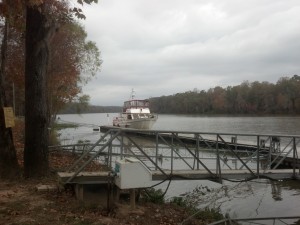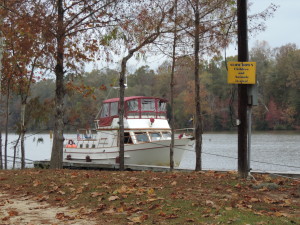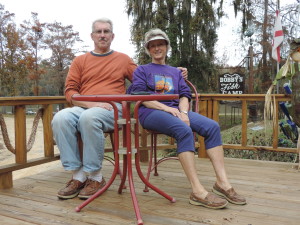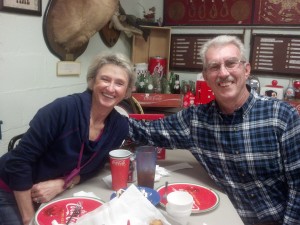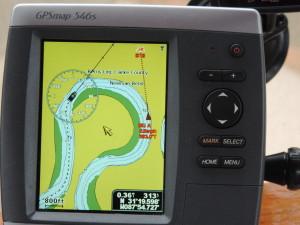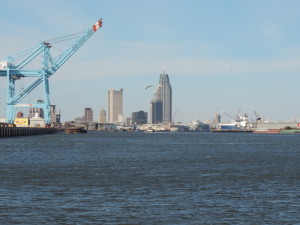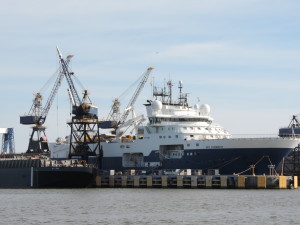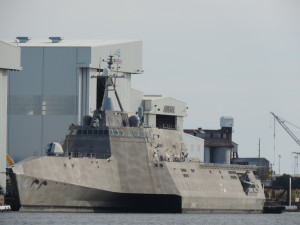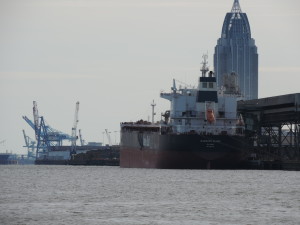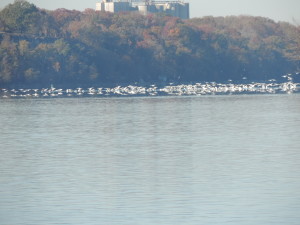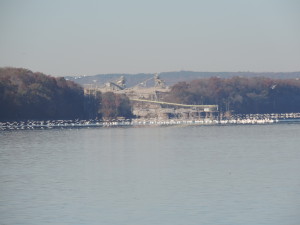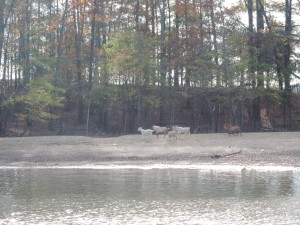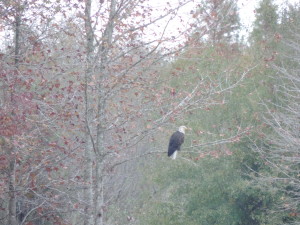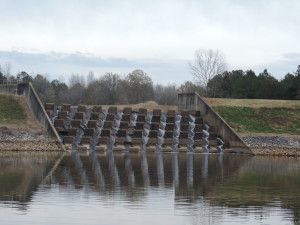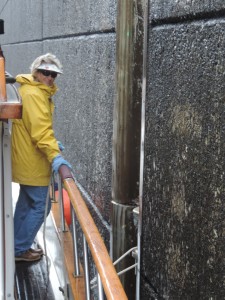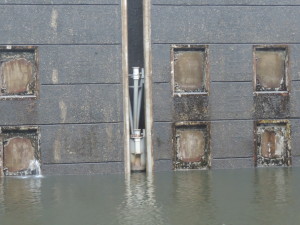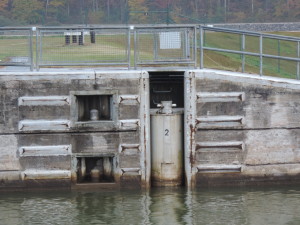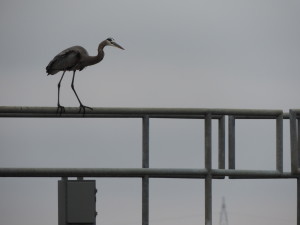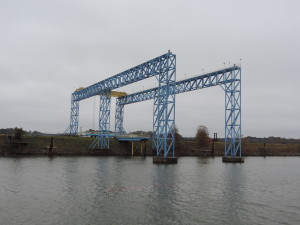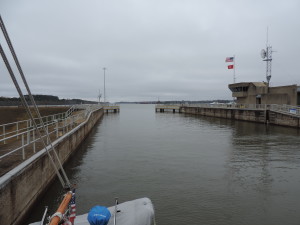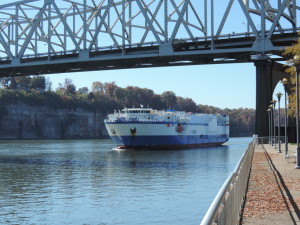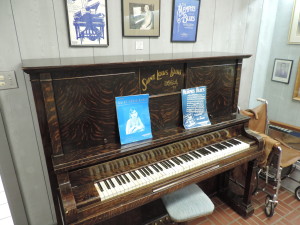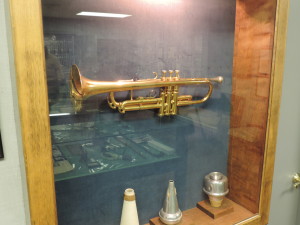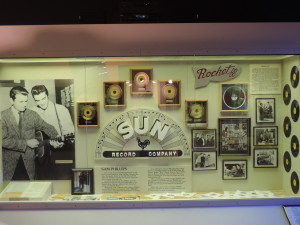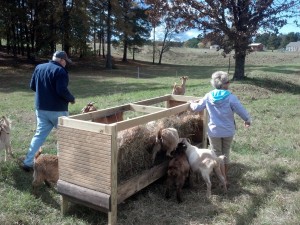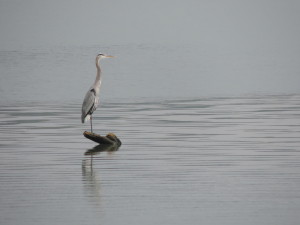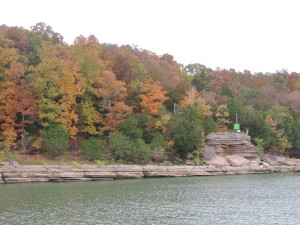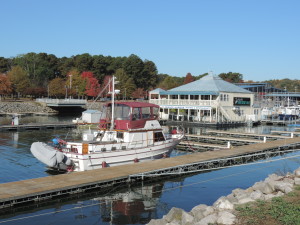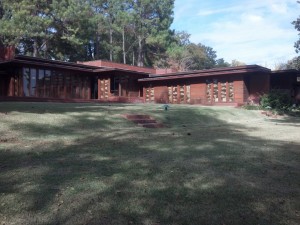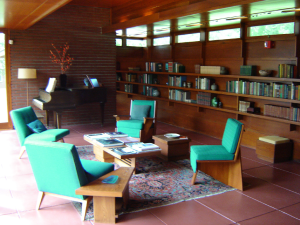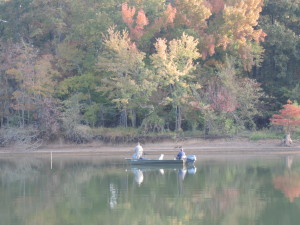2015-06-14 Sunday
After four months in the boat yard and almost two weeks getting things ship-shape (at least good enough), loading supplies and purchasing food, we cast off lines at 1415 Sunday, June 14, 2015, on our way toward Maine. Whether we make it that far with this late start only time will tell, but at least we’re going to make the effort. This will be our 13th transit of the Atlantic Intracoastal Waterway (ICW) so there’s not much we have to stop for on the way north; perhaps we’ll take more time when we head back south.
In the meantime, we’ll try to keep this blog up to date as much as possible (whenever we have a decent internet connection and time permits). For now, we anchored the first night out just south of the NASA railroad bridge near Titusville, and anchored the second night north of SeaBreeze Bridge in Daytona. We stopped short today so we could visit and have dinner with our friend who lives in Palm Coast – staying the night at Marineland Marina between Palm Coast and St. Augustine. Tomorrow we’ll continue heading north through St. Augustine and will probably anchor at Pine Island.
2015-06-23 Tuesday
Have a chance to update the blog. We went into Barefoot Landing Marina in North Myrtle Beach late yesterday afternoon and have a good WiFi connection via our antenna and router, so will do what I have time for before getting to work.
After leaving MCM, we anchored for the night just south of the NASA Railway bridge on the Indian River for the night. The next day, Monday, June 15th, we were underway at 0725 (the day was already hot) and anchoredat 1440 that afternoon at SeaBreeze Bridge in Daytona Beach, Florida. Had a quiet night with only one other boat coming into the anchorage. We had arranged to meet a friend from Palm Coast on Tuesday evening for dinner, so we were cutting our cruising days short so as not to arrive early. On Tuesday morning we were underway at 0730 and had lines to the dock at Marineland Marina by 1215, a cruise of only 32.9 miles and 4H45M! The air conditioning felt good after the heat of the last three days. We met Melissa (who presented us with various 30 amp and 50 amp electrical cords and a folding bike from her boating days on MV Fullstep) and then we went to an early dinner at a restaurant about five miles south of the marina (the only problem with Marineland Marina is that there are absolutely no facilities close at hand).
On Wednesday morning we were ready to move out. We departed Marineland Marina at 0650, transited St. Augustine (where we saw the Spanish Galeon Andalucia at the new docks) just south of the Bridge of Lions), crossed the St. Johns River at 1410, and at 1830 anchored at Cumberland Island, Georgia (mile marker 711), for a 90.2 mile , 11H40M, day!
On Thursday morning we were underway at 0720, overtook a “dredge train” with tug Rachael leading dredge Brunswick and tug George, passed through Little Mud River at near low tide where we saw a depth of 4.9 feet (mud bottom), and anchored at 1740 in Crescent River at mile marker 643.Had a very pleasant evening (although it was hot, with a nice breeze) and observed a brilliant moon, Jupiter and Venus in the same section of the sky just after sunset.
On Friday (June 19th) we were again underway at 0720, crossed the Savannah River into South Carolina after passing the same “dredge train” at Thunderbolt, Georgia, and anchored at Bull Creek (MM 565) at 1825, after a 78.6 mile, 11H05M, day! Since it was Friday, we grilled hamburgers for dinner!
The next day, Saturday, we were underway at 0715 and anchored in Church Creek (mm 488) at 1730, along with another DeFever trawler (this one heading to St. Petersburg, Florida.
On Sunday morning while doing a getting underway engine room check, I heard a drip-drip-dripping sound occurring about 3-4 times per second. No little aquatic animals nibbling at the hull, no leaking fuel – it was raw (outside) water leaking from a pipe on the engine heat exchanger. After checking the easy source first (a rubber hose) it was obvious that the leak was in the pipe itself. I wrapped it tightly with emergency tape (self-amalgamating tape), replaced the hose leading to the transmission oil cooler, and tested my handy work by running the engine and observing – no more leak! Even with that work we got underway at 0740. A check of the engine room about an hour later revealed no further leak, so we continued on through Charleston, South Carolina, past Mt. Pleasant and Isle of Palms, and anchored in South Santee River (mm420) at 1650 after 67.7 miles and 9H10M. It was unbelievably hot so we started the generator and then the two air conditioners; a short time later Judy said she smelled diesel fuel (her “smeller” is much more sensitive than mine) and when I checked the engine room the generator was leaking diesel fuel at the fuel filter/water separator housing. When I tightened the nylon plug less than a 12th of a turn, the plug snapped off at the base of the nut and fuel spurted out! Emergency generator shutdown, mop up diesel fuel (only a small amount), open windows, suffer with the heat!
Monday morning we were underway at 0620. On Sunday we had made reservations for two nights in a very nice marina in North Myrtle Beach anticipating a stop to take delivery of a new heat exchanger sent overnight FedEx on Monday from American Diesel in Virginia, install the new heat exchanger, and spend a cool night with the air conditioners running. Now it became a place to replace the heat exchanger and try to repair the leak in the generator. Shortly before we arrived at the marina we heard a loud pop and couldn’t determine what had happened – nothing had fallen from the mast, nothing seemed amis. Then Judy smelled propane and heard a hissing sound – it took us about 5 nanoseconds to determine that the propane line between the tank and the regulator had broken – and it took another 20 nanoseconds to turn off the propane. Now we had a third thing to fix in the marina (if we could find a new propane line). We arrived at Barefoot Landing Marina (MM 353) at 1630 after delaying an hour for a rather severe thunderstorm with high winds to pass to the west of us – it never came far enough east to be of any concern. It was nice to have air conditioning, get off the boat, walk around, and enjoy a meal ashore (we ate at Joe’s Crab Shack), oh yes, and have some ice cream!
On Tuesday the marina manager drove us to three different locations to shop for boat parts and a few groceries. The heat exchanger was delivered by FedEx before we left for shopping. By the time we returned it was too late to change out the heat exchanger, but I was able to fix the fuel leak in the generator (I hope), and replaced the propane tank hose. The heat exchanger can wait until the next marina1
Tomorrow (Wednesday) we head out again and probably won’t stop until we make a short stop for groceries at the northern end of the Dismal Swamp Canal in Virginia.
June 27, 2015 (Saturday)
A quick update while we have some surreptitious WiFi!
After Barefoot Landing for two days (where we were able to do some grocery shopping, I got the propane line part and fixed the generator so we can have air conditioning), we made good time northward. First night at Caroline Beach, North Carolina (just north of the Cape Fear River) at mile 295, then Mile Hammock Bay at Marine Corps Base, Camp LeJeune, NC, at mile 244, (where we stayed two nights to wait for better weather on Bogue Sound and also to allow Judy to put in a full day’s work on a case she had with a deadline), and today to an anchorage just off the Neuse River in South River (and a little creek off South River) mile 178. Storms with high winds are predicted for tonight and part of tomorrow, so we wanted a good anchorage with a lot of protection from the wind from the southwest, and this looked like just the place. We pulled into the little creek in a torrential downpour, but it soon let up and Judy was able to work the anchor windlass from the foredeck to get town 75 feet of chain in seven feet of water! We backed down on the anchor at 1200 rpm and we held firm – that should hold us through the forecast 40 knots of wind!
Only time will tell whether the storm materializes tonight, but the weather forecasts for this area for the past several days have been quite accurate, so we’re planning on rain and wind with gusts to around 40 tonight. Will let you know next time I’m able to update the blog
The first morning we were at Mile Hammock Bay we alerted the Coast Guard to a small skiff calling for help over the VHF. We could hear them, but apparently the Coast Guard could not, and after several attempt to establish a location for their boat via VHF, Judy called the Coast Guard using her cell phone. Shortly after that the Coast Guard attempted to contact the boat, but for whatever reason the boat wasn’t responsive but yet still continued calls for assistance at short intervals. The boat indicated they had taken on water in New River Inlet (just south of Camp LeJeune) and needed help. Hard to tell whether a call like that is a hoax or the real thing, but later in the morning the Coast Guard called Judy’s cell and informed her that SeaTow had found the boat full of water and washed up ashore and that everyone aboard was safe – they thanked Judy for her assistance. Nice work!
Just checked the weather forecast and WindGuru and while there are storms in the area the wind forecast isn’t as severe as it was four hours ago – now forecast to be SW with gusts to around 28! Much better than 40! And the wind forecast for tomorrow is just as good – generally less than 10 with gusts to around 20.
Wednesday, July 1, 2015
We have a little catching up to do and tonight we have WiFi so I’ll bring you up to date.
We left Big Creek on South River (off the Neuse River) on Sunday, June 28th, at 0945. The late start was caused by another small leak in the transmission oil cooler which Bob discovered at about 0615 as he was doing the morning engine room check. A little brushing with a wire brush, some JB Weld, and three hours later – we were ready to go! The Neuse River was a bit rough with winds out of the west at about 15 knots, and most of the day through the Pamlico River and the Pungo River was much the same. We continued on through the Pungo-Alligator River Canal to Tuckahoe Point at MM104, arriving at 2005 to a beautiful sunset and calm winds just about the time the pizza (which had been baking in the oven) was ready to eat! We spent a quiet night at anchor with no major wind, no storms and no bugs along with another trawler and a sailboat which were there prior to our late arrival.
On Monday, June 29, 2015, we were underway at 0635 after the first cool night of the cruise! No problems to deal with in the engine room! We were thru the Alligator River Bridge at MM84.2 at 0915, crossed Albermarle Sound with a 10-15 knot wind on our port quarter making the ride a little rough, and entered the Pasquatank River at 1145. We passed by Elizabeth City (and their terribly short, but free, finger piers) and anchored at Goat Island MM45 at 1515. The rest of the day was fairly pleasant – Judy working and Bob got a nap (a rarity these days).
Tuesday, June 30, we were underway at 0615 in order to arrive at South Mills Lock of the Dismal Swamp Canal in time for their 0830 lock thru (the first of four of the day). About the time we reached the narrow part of the river we were hailed by another boat also heading to the lock; we arrived in plenty of time and had to “tread water” for over half an hour before we the lock doors opened and we were able to lock through, clear the bridge (which is raised after the lock is raised), and proceeded into the canal. The canal runs for about 21 miles from South Mills to Deep Creek, with a bridge and lock at each end. The only openings each day (during the season) are at 0830, 1130, 1330 and 1330 – if you don’t make one of those openings you stay in the canal at the visitor’s center, Elizabeth’s Dock (at Deep Creek), or just drop a couple of anchors. The boat that had come up behind us exited South Mills Lock before us (they were going to travel slightly faster) so arrived at Deep Creek about 10 minutes before us at 1215 and tied to the “shopping dock” near a grocery store. They invited us to raft with them, which we did, and then went shopping for a few items while we waited for the 1330 lock-through. We both locked through at 1330 and cleared the lock and were on our way to Norfolk by 1410. In Norfolk we stopped at the Ocean Marine Yacht Center for fuel. It was only the second time we had put fuel in our new tanks so were interested in seeing how well it worked; we now have four fuel fills (one for each tank) rather than the two previously. While I had anticipated that we had used anywhere from 210 to 250 gallons of fuel on the trip from Florida, we were able to squeeze only 283 gallons of fuel into the tanks, making us think that the tanks do not hold 540 gallons as stated by the tank fabricators, but more like 450 gallons – plenty of fuel no matter what the numbers. We topped off the water tanks and got rid of all of our trash, then continued northward.
After leaving Ocean Marine Yacht Center we checked the weather forecast again and discovered that high winds from the south and west were forecast for the night, so instead of going to our “usual” anchorage near Old Point Comfort which is exposed to the south and west, we opted to anchor in Willoughby Bay on the north side of the Navy base. After checking out several locations, we opted for a spot just to the north of the base marina outside of the restricted zone where we would get some protection from waves from the west and south. We anchored at 1840 to the sights and sounds of Navy helicopters practicing shipboard landings at the small air strip just to the south of us. They would fly almost directly over us as they took off from the field, then circle around, hover over a simulated ship deck, then lift and come around again. This continued well into the evening. The winds also continued well into the evening, and (Judy reports – Bob was sleeping) that around 2230 to midnight the winds had picked up to almost 60 MPH with the sky full of lightning as she stoodd anchor watch in the saloon with Sanderling cork-screwing in the wind and waves. The anchor held tight, however, and we were in approximately the same place after the storm passed and things quieted down for the rest of the night.
Today, July 1st, 2015, we were underway at 0800 to sounds of the Star Spangled Banner being played over loud speakers at the Norfolk Naval Base! Seas were just a little rough as we left Willoughby Bay, but soon settled down after we headed north about a mile off the western shore of Chesapeake Bay. At the entrance to the Rappahannock River we turned slightly to the west to head for the entrance to the Great Wicomico River where we anchored off Sandy Point at 1635 with a gentle breeze and clear skies.
Tomorrow we’ll depart early to get to Solomons, Maryland, and a buoy at Zahnizer’s Marine Center, then on to Selby Bay Marine on Friday where we have reservations for three nights so we can spend a few days with our daughter and her significant other.
Follow us on Marinetraffic.com
July 5, 2015 (Sunday)
Now at Selby Bay Marina on Selby Bay, just off the South River south of Annapolis, Maryland. We’ve traveled almost exactly 1,000 NM miles from our home marina in Florida this trip. This is very close to Jen’s house in Edgewater, so we were able to spend the weekend with her and Don after arriving at the marina on Friday, July 3rd, after departing Solomons, Maryland, at 0620 on Friday morning. The trip from Solomons was fairly smooth on Chesapeake Bay, with several other boats (sail and power) departing Solomons basically heading to Annapolis and their great 4th of July fireworks display. It was only a 48.4 NM cruise for us since we stopped about 6 NM short of Annapolis. As we approached the entrance to the South River the number of boats on the water increased substantially, with apparently many boaters out for a long weekend. Once we turned into Selby Bay things quieted down. The marina had assured us that we could fit under their covered slip (the only slip they had available), but when we saw it we approached very slowly at low tide and even then we wouldn’t fit. The young man on the dock (son of the owner/manager) had no idea how high the opening was – only that it wouldn’t be a problem. We assured him that the opening was less than our 22.5 feet in height as Judy watched from the stern as I moved forward very slowly. We backed off and the young man called his father to try to locate another slip for us – there wasn’t one. So we offered to lower our radar mast so we would fit. We pulled up to the fuel dock and the owner and his son came aboard to help us lower the mast by hand (normally we use a gin pole and a six part rope fall). The mast was down in short order and we were in the slip with plenty of room above our 15.5 feet at the bimini top! Next came trying to figure out the electricity, which also seemed to be a mystery to the young man working the dock as well as his father – but that eventually got resolved, also. We met up with Jen and Don for dinner at a great German restaurant nearby, then had a quick tour of their neighborhood and their house – a nice little bungalow about 1 block from the Bay.
The trip from Sandy Point to Solomons on Thursday started quietly at 0630, but by the time we had crossed the mouth of the Potomac River and had Point No Point Light to port the weather turned on us. The wind shifted to the north at 20 to 25 knots and the temperature dropped about 10 degrees. With the wind from the north and an opposing current, the waves picked up and it was a rough ride for two hours before we rounded Cedar Point and headed up the Patuxent River to Solomons and a quiet mooring ball at Zahnizer’s Yacht center. We prepared the dinghy for use (we hadn’t used it yet on this cruise) and went ashore to eat at one of our favorite restaurants in the area, C&D Cafe! Fortunately we got there early enough that it wasn’t too crowded and we were able to get one of the last tables for two.
Our 4th of July started with Bob spending about 5 hours in the engine room changing out the heat exchanger and two oil coolers (the two coolers arrived at Jen’s earlier in the week). Bob also replaced the electric horns (one of which had stopped working) and put in a new “approved” propane pigtail (all ordered from Defender earlier in the week and shipped to Jen’s). We also have a new rebuild kit for our two heads! The joys of cruising. Judy spent the day working on some of her cases. Later in the afternoon (Bob didn’t even get a nap), we met Jen and Don for hamburgers and hot dogs at their house, then walked around their neighborhood, returned for ice cream and walked to the beach to watch some fireworks across the Rhode River from their beach. By the time we got back to the boat we were both exhausted, went to bed and didn’t wake up until after 0800 this morning.
Tomorrow we’ll try to get out of here by 0630 heading north up the Bay. Bob has rigged our rope fall and gin pole so we can raise the mast by ourselves once we clear the slip. We’ll stop at Veasey Cove, Chesapeake City, or Reedy Island (Delaware Bay) depending on how the tidal currents treat us. After that we’ll stop at Cape May, New Jersey, then Atlantic City, and then the big run to Great Kills, Staten Island. From there it’s through New York City and the East River to Long Island Sound, east on the Sound to Rhode Island and Massachusetts. May not have a chance to update the blog between here and there (not sure where “there” might be), but you can follow us on Marinetraffic.com, if you wish.
July 13, 2015 (Monday)
Trying this for first time. Came into Great Kills Harbor yesterday and took a mooring from Richmond County Yacht Club for the night. Judy had a package waiting for her at a nearby UPS store which she picked up at 0800 this morning. Now we’re waiting for the tide to change to flood on the East River in NYC so we won’t have to battle the current (and go backwards) at Hells Gate.
Trip up the NJ coast on Saturday was fairly calm. Saw two whales (we believe to be humpbacks) at different times during the 13.5 hour cruise. Anchored for the night at Sandy Hook, NJ then came the 8 miles to Staten Island on Sunday morning. Had a little excitement involving watching the CG at Sandy Hook respond to an injury aboard a vessel before we got underway.
In less than an hour we get underway for NY harbor, the East River and into Long Island Sound.
More later.
July 14, ,2015 Tuesday
My calculations for the best time to transit the East River didn’t work out and we had a slight current against us until about the time we reached Hell Gate and then the slack tide finally caught up with us. We continued into Long Island Sound and then into Manhasset Bay where we took a free town dock mooring ball for the night.
Today we were underway at 0850 and had our lines to a mooring ball in Port Jefferson at 1410 after 36.5 NM and 5H30M. Tonight we took the launch ashore for dinner at a great little restaurant (Zpita) where we ate during a major rain shower which stopped just in time for the conclusion of our meal and a walk back to the launch dock via a great ice cream store!
Tomorrow (Wednesday) we head for Montauk where we’ll anchor in the pond, possibly for two nights waiting for winds on Thursday to calm down enough to get to Martha’s Vineyard.
July 25th, 2015 (Saturday)
We stayed in quiet Montauk Pond for two nights while winds subsided on Block Island Sound on the 16th. The night of the 16th we ate in the very upscale (ritzy) Montauk Pond Yacht Club and Marina with reservations at 1800 (thank you very much). The Adarondak lawn chairs were perfectly lined up along the manicured lawn so anyone who wished could sit and watch the sun set over the “pond.” We dinghied to the club from our boat anchored about a mile north of the club. Great meal and nice evening!
We were underway in Montauk Pond at 0630 on the 17th (Friday) and headed out into a fairly calm Block Island Sound, past Block Island and Narragansett Bay (and Newport) and into Buzzards Bay. We originally had planned to go to Martha’s Vineyard, but the weather forecast for later in the weekend caused us to opt instead to go into Buzzards Bay instead in order to avoid further delays in getting to Maine. We tried to anchor in Clark’s Cove about 1645 but could not get the anchor to grab despite repeated attempts, so went back to the west around a short peninsula into Apponagansett Bay and took a mooring at the New Bedford Yacht Club at 1745. After the tender showed us the mooring, we discovered that since we were leaving the next morning and weren’t going to use the tender service nor go ashore, we would not be charged for the use of the mooring for the night! It was a good, quiet night on a mooring.
Saturday morning we case off from the mooring at 0635 in order to catch a fair tide all the way up Buzzards Bay and through the Cape Cod Canal. The wind picked up slightly throughout the morning, and by the time we transited Cape Cod Canal (where our speed over the ground topped out at 10.5 knots with the current) and entered Cape Cod Bay it had picked up a bit more. When we turned slightly westward to follow the shoreline leading to Plymouth, Massachusetts, it picked up considerably and the waves were approaching 2-3 feet with gusts to 20. We made it through the channel into Plymouth and contacted the Plymouth Yacht Club for directions to the mooring (which we had reserved), and after a great deal of difficulty picked up the mooring only to realize that we were much too big for the mooring and the surrounding space; the yacht club staff in the tenders agreed and we moved to another mooring with much more room. Judy and the tender driver working together were able to snare one mooring pendant, and then we secured both mooring pendants (two to a ball to make a yoke) with extra line and felt we would be OK for the night. We were secure on the mooring at 1330. The wind continued blowing at 20 knots with higher gusts, so we bounced around a bit. We went ashore later in the afternoon when the wind started to die down a bit we took the tender ashore, confirmed that we would be able to stay a second night night if the winds didn’t improve, and ate at a great little sub shop not far from the marina after walking around town a bit (saw the remnants of Plymouth Rock, looked at the Mayflower replica from a distance, dodged traffic), and then had some great ice cream for desert!
The wind had died down completely by late in the evening and everything looked good to transit Cape Cod Bay and Massachusetts Bay on Sunday. We dropped the mooring at 0640, July 19th (Sunday) heading to Rockport, Maine, at the eastern end of Cape Anne. After about three hours we changed course for Gloucester, Massachusetts, in order to get fuel (we had heard that prices for diesel there were low). We stopped at a fuel dock in Gloucester at 1305, took on 235 gallons of diesel (not at a low price), and departed the fuel dock headeing to Rockport at 1400. We had reserved a mooring at Rockport earlier that day, so when we arrived at Rockport we called the harbormasters office to ask for the location of our mooring. Scott and Rose identified themselves as being on a boat in the harbor and asked if we’d ever taken a fore and aft mooring before; when we let the know that we had not, Scott said he’d come aboard to help us – and before we knew it they were alongside and Scott hopped aboard. This turned out to be the secret to cramming so many boats into such a small space with current from a 9 foot tide – all the bigger boats in the harbor (actually on the south side of the fairway) are tied to moorings at the bow and stern. Scott first talked to me to tell me what we were going to do, then he went forward and talked with Judy. He directed me to a pickup float at the far end of the harbor, he and Judy reached down and picked up the float and hauled it aboard. It was attached to a small stuff line which was in turn fastened to a mooring pendant which would be attached to the bow and a second mooring pendant which would be attached to the stern; both pendants were attached to different locations on the bottom of the harbor and both “ends” had two pendants to form a yoke. By the the time we were through Judy had secured two pendants to the bow, Scott had jumped back on the harbormaster’s boat with Rose driving, reached under the water with a boat hook and grabbed a ring containing the second stern pendant, attached one of our spare lines to the second pendant and had us pull it aboard and cleated at the starboard side of the transom. We were fast in the harbor, fore and aft, facing the harbor entrance, and would not swing with the shifting tidal current or the wind. Other boats were similarly moored no more than 15 feet away. Quite a setup! We ate dinner aboad, then took the dinghy ashore and had ice cream for desert. We like Rockport so much that we stayed a second night in order to walk around the town. The second day we ate a lobster roll for lunch, had a nice dinner ashore with ice cream for desert AND walked around the waterfront area during the day. Rockport, Massachusetts, is still one of our favorite New England towns!
From Rockport we were underway on Tuesday, July 21st, at 0845, and headed to the Navy marina at Sound Basin, Kittery, Maine (across from Portsmouth, NH) with a great view of the old Navy prison where Bob was stationed for a year in 1966-67. We had fog all the way from Rockport to Kittery, and could only see other boats and land via radar, most of the time. We stayed a second day so Judy could get blood drawn at the small clinic there for her doctor in Florida. We also did some shopping at the commissary. Nice place to stay and we had two quiet nights on a mooring (after a storm passed through late on the second afternoon).
We departed Kittery, Maine, a 0630 on Thursday, July 23rd, heading to Portland, Maine. We saw at least one whale southbound about half way and think it might have been a minke whale – rather small – definitely not a humpback or northern right whale. We had lines to the slip at the South Port Marina at 1410 that afternoon. Dinner at our friends Norm’s and Nancy’s house that evening, grocery shopping and a trip to West Marine for a new yacht ensign and VHF radio then dinner out with Norm and Nancy on Friday. Tonight we went with them and other neighbors to a concert at the Cape Elizabeth Lighthouse by the Portland Symphony Orchestra – great evening, great company, great food prepared by Norm and Nancy.
Tomorrow we meet Norm and Nancy for brunch, then we’re heading to South Freeport for at least one night and some of the best lobster rolls in Maine!!!
More later!
Friday, August 7, 2015
WOW! I didn’t realize it had been almost two weeks since I updated this blog. You can’t believe how much effort it takes to keep it relatively up to date when you’re cruising. Tired after a day underway, things to do, meals to prepare and cook, shopping to do, places to visit, no internet access, – to name a few things that get in the way.
We’re now on a mooring at the Wooden Boat School on Eggemggin Reach near Brooklyn, Maine. Arrived here about noon today after departing Pulpit Harbor (across the bay from Camden, Maine) earlier in the morning and having an absolutely spectacular New England (Maine?) day on the water for three hours between points. We went ashore and visited the grounds of the Wooden Boat School. Bob took two 2-week courses here in 1988 and 1990 – place actually hasn’t changed much, except it seems a lot busier. Rich (the current Director who was the shop foreman when Bob was a student) said they had nine courses going on this week, including a women’s sailing course and a week-long cruising course in addition to all the boat-building courses. What a great place!
I’ll try to bring everything up to date later this afternoon (after my nap).
Nap and dinner are over with. Now for a big update!
Thursday, July 23rd, 2015 – Portsmouth, New Hampshire (actually, Kittery, Maine)
After a stormy afternoon on Wednesday and shopping at a small base commissary on Wednesday, we dropped the line to the mooring at the Navy marina at 0630 and headed out the Piscataqua River, then north to Portland, Maine. The ocean was fairly calm and we made a course straight from the sea buoy at Portsmouth to the light at Cape Elizabeth. Seven hours and 40 minutes and 49.8 NM miles later we were in a slip at South Port Marina in Portland, Maine. About half way we saw a whale (probably a finback) heading south; this was one of about six whales we’ve seen on the trip, the first off the coast of New Jersey. We had dinner with friends Norm and Nancy at their beautiful summer home on Cape Elizabeth, then went back to the boat for a quiet night’s sleep knowing we didn’t have to get up early the next morning to get underway.
While in Portland we spent every evening with Norm and Nancy. Dinner at a nearby restaurant on the second night, and on the third night we, along with a group of neighbors, attended a 250th celebration at the Portland Head Light at Cape Elizabeth for a picnic and a pops/light classical concert by the Portland Symphony Orchestra. By the end of the evening everyone was huddled under blankets, even the Mainiacs! We also did some boat shopping with Norm (had to buy a new yacht ensign since the old one had torn and a new VHF radio to replace the inside radio that had decided it wouldn’t receive any of the Coast Guard channels), and some major grocery shopping at Hannafords.
We also met a couple in the marina where we stayed who had recently purchased a DeFever 41 (same as ours) built a year later than ours in the same boat yard. The boats were almost identical in outward appearance, and both Bob and Judy were able to answer many of their questions about how things worked and where various systems were located.
Sunday, July 26, 2015 – Portland, Maine
We had brunch with Norm and Nancy and a visiting friend, then got underway at 1325 after taking out the trash and filling the water tanks. We had a short 13.8NM and 2H05M day going to a mooring at Strauds Point Sharf at South Freeport, Maine, basically north of Portland. We stayed a second day and took a taxi to Freeport, Maine, home of L.L. Bean, as well as many outlet stores from all of the major retailers. We bought a few things at Beans, and Judy found some new boat shoes at one of the other stores. Dinner consisted of more lobster rolls at a lobster shack at South Freeport; we concluded later that we’ve already had our fill of lobster rolls after two dinners – we think lobster is good in some things, but neither of us consider it a delacacy.
Tuesday, July 28, 2015 – South Freeport
We cast off the mooring line at 1010 with fog rolling into the small harbor. By the time we cleared the harbor we were in a heavy fog navigating by AIS and radar, listening for fog horns and the sounds of nearby boats. The fog would clear slightly, then come back in. Most of the three hour trip to Snows Island was in fog through heavy concentrations of lobster pot foats; in several places the floats and the fog were so thick we had to rely on our radar to identify floats in front of us in time to avoid them as we headed up Qauhog Bay with less than 1/16th mile visibility! However, by the time we neared Snows Island the fog lifted and the sun came out to reveal the beautiful anchorage that we remembered from past years. We had the anchor down northeast of Snow Island at 1310 after traveling 3H00M and 18.9NM.
While at this anchorage I had time to catch up with a few things, although there was no internet access. One of the things I was able to bring up-to-date was our electronic log which contains all the data about time, distance, and location in a spreadsheet that displays time underway, statute and nautical miles, etc – all the essential data about our cruise. Here are the cruising stats to date for our cruise:
Total hours underway: 265H30M
Total miles: 1635 nautical miles; 1899 statute miles
On Wednesday, I changed the engine oil and oil filer! We also took a dinghy tour around the island and just enjoyed the quiet, beautiful scenery.
On Thursday, July 30th, we were underway at 0640 in calm, partly cloudy weather. We made good time around the headlands to the east of Quahog Bay and then set course to the northeast into Boothbay Harbor where we took a mooring at Browns Whart, across the harbor from the main town area. About half way we saw seals sunning on the rocks at Fuller Rock – not an uncommon sight but something that we don’t see very often because they like the sun (not fog) and the rocks need to be exposed at high tide – a combination that doesn’t occurr very often when we happen to be in the area.
We took the trolley to the main part of Boothbay and walked the streets with the rest of the tourists. Not much of interest there, but we did find a beautiful painting by a local artist that will go well with another painting from Rockport, Massachusetts, that we have at home (we bough the painting thinking it would look good on Sanderling, but when we got it back to the boat we decided that it was too nice to keep on the boat). We also walked around the harbor to the Boothbay Harbor Shipyard where the Bounty was restored a few years before her ill-fated voyage into the eye of a hurricane! Now they’ve just started work on another wooden ship, the Ernestina-Morrissey (check for the details using Google). It will be a $6 million dollar, 7 year project for the restoration of this beautiful schooner owned by the state of Maine used as a sail training classroom!
On the second day we took our dinghy across the bay and tied up at a dinghy dock in the middle of town. Just after we’d had lunch, we just happened to see a lobster boat in the downtown area with several passengers (obviously not lobstermen) and a sign indicating that the boat was a working lobster boat that gave demonstrations of lobstering. We followed the boat to it’s dock and inquired about the next “class” – it was going to take place in another half-hour where we’d go out with the two lobstermen who would raise six pots with their lobsters and explain what they were doing. We were on the next trip! What a great afternoon with the men. They were extremely informative, answered questions, explained everything they were doing, and obviously enjoyed helping us learn their trade. It is something we’ll never forget, and their explanations helped us understand what we were seeing every day we are on the water up here in “lobster country.” Earlier that day we had called for the free pump out boat to come alongside and pump out our holding tanks. Since so much of the area here is a “no discharge” zone (meaning you cannot pump even treated sewage overboard) many of the towns and harbors offer this free service in order to encourage boaters NOT to dump sewage overboard – a great idea!
Saturday, August 1st we were underway at 0825. We would have loved to stay another day or two in this lovely area, but new areas beakoned! We entered the Damarascotta River a short distance from Boothbay Harbor timed to get the mid-flood tidal current on the river and a gentle push through “The Gut” which was a narrow part of the river where the normal ebb and flow of the tide creates extremely fast currents. Turns out we received a 4 knot “push” through The Gut before turning 180 degrees o enter Seal Cove, an anchorage we had read about in our cruising guides reputed to be one of the most beautiful in Maine with its own family of seals. Sure enough, the area was beautiful, we timed the tide well and had plenty of water over a shallow area leading into the anchorage, and the seals entertained us most of the afternoon after we anchored at 1000 after 1H35M and 10.8NM underway.
On Sunday, August 2nd we were underway at 1120 and at 1405 we had taking a mooring at Round Pond after 17.1NM and 2H45M. This was a mid-day change from our original plan of going to Hog Island and the Audobon Preserve we had visited in 2006. We’d never been to Round Pond (more or less on the way to the Audubon Preserve) so we decided to see something new. We’re glad we did. Round Pond is a delightful small working harbor with just a few mooring balls that are rented out by the local boat yard. As we were looking for an available mooring the boat yard owner and his family showed up in a small center consel boat and to help, and a boat on one of the rental moorings told us that they were leaving and that we could take their mooring which had plenty of swinging room. Interestingly, the boat that left the mooring had spent the afternoon with us in Seal Cove the day before (one of a few boats that came to Seal Cove for a few hours to watch the seals). We dinghied ashore for dinner in a restaurant, followed by . . . ice cream!
The next day, Sunday, August 3rd, we were underway at 0655 heading to Camden. We entered Penobscot Bay at 0825 and soon encountered heavier swells, lots of lobster floats, and FOG! One or two of the three alone isn’t bad, but with the fog, floats, and then heavy swells it makes for a tiring day having to hand-steer (rather than rely on the auto-pilot) all the time to deal with the swells and the pots. We could hear fog hors, see boats and ATONS on radar, and some other boats on AIS. We could also hear boats talking with each other arranging passage in the fog. Everything demands our undevided attention and it’s very tiring. AIS helps tremendously as we’re able to identify the larger vessels (and they us) and talk with them by name to arrange a safe passage. We were glad when the fog started to lift as we approached Camden Harbor and were directed to our mooring for the next two days.
Camden is an interesting town with lots of shops, restaurants, and boats. The thing that boaters do not see, however, is the harbor. It’s a large harbor filled with mooring balls, almost all of which are occupied. Some of the moorings are privately owned, some owned by the yacht club or by the one marina. The harbor faces south-southeast, but even a southerly wind combined with the tidal current seems to constantly stir up the water in the harbor making a very rough ride at the moorings. We only had a few hours of calm each day before the wind and tidal current set the washing machine in motion, again.
We walked the streets, did a little food shopping at a very small food store, and took real showers at the marina! We also filled our water tanks before leaving so we would have an adequate supply to get us to our next marina where we could get water. We had hoped to climb Mount Battie (lies just outside Camden) the second day we were there, but we woke up to fog and rain which continued into mid-morning, so had to forego our second ascent (the first was in 2006)!
We were happy to depart the rockin’ rollin’ harbor of Camden for smoother harbors on Wednesday, August 5th. Before departing the harbor we went to the marina’s fuel dock for water and trash disposal, then headed to Southern Harbor, which is on North Haven Island, just across Penobscot Bay from Camden. It’s a nice, quiet spot and we were the only boat anchored there. The next day we went to Pulpit Harbor on the same island (just about 2 miles directly across the island from Southern Harbor but 12 miles by boat). Pulpit Harbor is a place where every boat on Penobscot Bay stops – it’s crowded, quiet, and anchorage room is limited, and holding is rather poor, but the sunsets (if there is a sunset) are spectacular and it’s well protected from winds. We stopped there for a night in 2008; we probably won’t stop there again!
We departed Pulpit Harbor this morning at 0850 and arrived at the Wooden Boat School at 1220 after 23 NM. The water was spectacularly beautiful with very little wind all the way through Eggemogin Reach to the Wooden Boat School which sits on the northern shore of the reach toward the eastern end. Eggemogin Reach is renouned for it’s great sailing, since it is one of the few places in Maine where sail boats can sail beam reaches (the wind on the beam) with the prevailing south-westerly summer wind for about 10 miles, then turn and have a beautiful beam reach back up/down the reach. We arrived to find an available guest mooring on the outer perimeter of their mooring field filled with beautiful wooden boats, most built at the school by their week and two-week boat building classes. We toured the grounds, talked with the director, and headed back to Sanderling for a peaceful afternoon in the warmish Maine sun.
The next three days will put us about 22 NM east of our current position. We’re going to depart WBS tomorrow and go a few miles to Buckle Cove and then Mackaral Harbor before going to Northeast Harbor on Mount Desert Island for a few days.
Weather is forecast to be great for the next week or so – hope the forecasters are accurate as we still have a lot of Maine to see before heading south toward the end of the month.
Wednesday, August 12, 2015 – Sommes Sound Harbor, Maine
A quick update while we have decent internet.
One thing I may not have mentioned earlier is the matter of the distance and time that we’ve cruised that I try to remember to note in the blog. Distance is determined on a daily basis, taken from our two chartplotters which (we hope) we reset every day when we’ve finished cruising that day and are anchored, at a mooring or at a dock/marina. We work with nautical miles now that we’re out of the Atlantic Intercoastal Waterway (ICW), but while we’re in the ICW we use statute miles since the ICW is measured in statute miles rather than nautical miles. Time underway is based on our own observation of the time when we let loose a mooring, raise the anchor, or cast the lines off a dock if in a marina, and again when we anchor for the day, take a mooring, or go into a slip or dock at a marina; the difference is our underway time. The engine is actually running before we get underway by at least 5 minutes or so when starting for the day (longer if we know we’re immediately going to have to get up to full speed, such as in a river with a current) and may run 5-10 minutes after we are no longer underway (when we stop for the day) while we shut off various systems and throttle back to engine rpms to let it cool down before turning it off. Both the distance and the time underway are noted in our ship’s log at the end of each day’s run, then entered in a spreadsheet which calculates total time and total distance, both nautical and statute miles, as well as some averages I like to keep track of and the number and percentage of times we anchored, paid for a mooring ball (or got one free), or paid for a marina or got a free dock.
We departed Wooden Boat School on Sunday, August 9th, 2015, after spending two nights there. We had beautiful sunsets each evening, the weather was perfect with sunny days and quiet nights, but we had to move on. We had intended to go into Buckle Harbor on Swans Island just to see what it was like and then go a short distance further and anchor in Mackeral Cove, but when we got into Buckle Harbor we thought it was so nice and peaceful that we decided to anchor there for the rest of the day and that night. We weren’t disappointed. Two sailboats came in during the day, but the harbor is so large that they anchored some distance away and we hardly noticed that we had company.
Day: 6.1NM – 1H00M
Trip: 1798.2NM/2066.3SM – 288H05M
The next day, Monday, August 10th, we were underway (anchor up) at 0930 and at 1145 had our lines to a floating dock in Northeast Harbor on Mt. Desert Island. We had fog most of the way, and as always here, lots of lobster pot floats!
Day: 14.0NM – 2H15M
Trip: 1812.2NM/2082.4SM – 290H20M
As we were coming into the harbor friends Glen and Jill on Last Dance hailed us on the VHF radio to let us know that the other side of the floating dock they were on was free, so we had a nice get together with friends whom we see from time to time when we cruise. After going ashore and paying for the mooring, the four of us took their dinghy to another floating dock across the harbor and climbed the 200 steps and the paths to Thuya Gardens which overlooks the harbor and still has many flowers in bloom. After we descended the steps we walked about a mile along the road to an Asticou Azalea Garden created in the Japanese style – both beautiful places to visit; unfortunately, we missed the azalea season by several months! On Tuesday Glen and Jill departed for Sommes Sound, then Judy and I took the free bus into Bar Harbor where we had arranged to get our hair cut at one of the salons, ate breakfast at a little sidewalk cafe next to the salon, and replenished our food supplies at a Hannaford market just down the street. After completing our grocery shopping we schlepted our bags back to the bus stop, took a launch from the harbormaster’s office to Sanderling, and got our groceries aboard just as the rain started to get heavier! Later in the day the rain and wind intensified and we had quite a storm before everything stopped around 2300 in the evening. Our weather station clocked winds as high as 28 knots and we had about 1″ of rain during the day. Between the wind and the rain (and being on a stationary dock so we didn’t cock into the wind) we found a few wind-driven leaks around doors that need to be addressed when we get back to Florida.
Today, Wednesday, August 12th, we filled the water tanks and cast off from the dock at 1035 after waiting as long as we could for the fog to lift. It kept coming and going, so finally we just worked our way out of the harbor using the chartplotters, radar, and AIS (and a sharp lookout) and westerly around the southern end of the island into Sommes Sound (a fiord), up the sound to Sommes Harbor (a small community) and took a mooring at 1145. By the time we got to the harbor the fog had lifted but the sky was still overcast and didn’t clear until later in the afternoon when the sun finally peaked through.
Day: 6.5NM – 1H10M
Trip: 1818.7NM/2089.8SM – 291H30M
We’re going to stay here another day and take the free bus to Southwest Harbor just to see the area and check out Hamilton Marine and West Marine in case they have something we need for the boat. Perhaps we’ll luck out and find ice cream!
Weather for the next week looks good, with relatively gentle waves on the ocean to the east, we we are planning to depart this nice spot on Friday and head about 40NM to the east to the Roque Island area, stay a day or two there, then return to Northeast Harbor for a night. At that point we’ll start to work our way west back to Casco Bay where we’ve reserved a mooring at South Freeport starting on the 25th of August for 10 days. More about that later!
Saturday, August 15, 2015
One thing about boating, plans are always subject to change – as we have so many times. Rather than heading further east,from Somes Harbor, we decided to start a slow trip back to the west. For one thing, we’ve already “been there; done that” back in 2008, and for another we were concerned that we’d get further east along the ocean and then have the weather change to something less comfortable which would result in delaying our return to South Freeport. So, our plan changed the last night in Somes Harbor.
On Friday, August 14th we were underway from the mooring at 0815, stopped at Able Yacht Yard at 0830 to pump out our two holding tanks, and were again on our way at 0905. We transited Somes Sound and then southward past the Cranberries, then hung a right and headed east to Mackeral Cove. We had the anchor down at 1145.
Day: 18.3NM – 2H55M Trip:
We plan to stay here through tonight (the 15th) and later tomorrow (Sunday) check on the availability of a mooring (first come, first served) at Frenchboro (Long Island) and the Thorofare (Isle au Haut) and stop at the first location with an available mooring. If not either of those, then we’ll move on to Seal Harbor on Vinylhaven where we’ll spend a couple of days. After that: Hog Island, Goothbay, the Basin (Casco Bay), and then on the 25th to South Freeport. Sounds like a plan – subject to change!
Monday, August 31, 2015 – South Freeport, Maine
Just looked at the blog and realize we’re half a month behind. I’ll do my best to get you up to date now.
We had a nice two-day stay at Mackerel Cove on the west side of Roderick Head. It was quiet, good holding, the weather was sunny, and only a few other boats came into the area to anchor while we were there. We departed on Sunday, August 16 at 1015 and by 1135 we’d traveled 8 NM and taken a mooring at Lunts Harbor, Long Island, Frenchboro.
Day: 8.0NM – 1H20M
Trip: 1845.0NM/2120.1SM – 294H25M
What a delightful visit we had in Frenchboro. It’s a small island owned by the state of Maine as a conservation preserve. There are only a few houses scattered around it’s small harbor with fewer than 20 families living there year around. It’s great claim to fame for cruisers is Lunt’s Dockside Deli serving up relatively inexpensive lobster dishes such as steamed lobsters (of course), lobster mac and cheese and lobster grilled cheese sandwiches! We had lunch (the mac and cheese and the grilled cheese) then walked the road which winds around the harbor, stopped at the museum/gift shop, and then headed
back to Lunt’s Deli. We arranged to pick up a home made pizza for dinner (“should I just run a tab?” – “sure”) and I watched the lady make a fresh ice cream sandwich with two home made chocolate chip cookies and two scoops of home made vanilla ice cream that I needed before we headed back to Sanderling on the mooring. Earlier, while walking around the harbor, we noticed a boat that looked familiar take a mooring, and we both commented that it looked like Bruce and Joan Kessler’s Spirit of Zopilate – a beautiful one-off boat that is hard to miss. We didn’t think much more about it, but as I was sitting at Lunt’s eating my ice cream sandwich we watched a dinghy leave that boat with four people aboard; as they drew closer and tied up at the dinghy dock we readily identified Bruce and Joan (we’ve met them a number of times over the years and shared steamed crabs with them at a table at several early Trawler Fests). The other couple came up the ramp from the dock to Lunt’s and the guy was wearing wrap-around sun glasses which mostly hid his face. When Bruce and Joan came up the ramp I wiped as much ice cream from my face as I could and stood up and identified myself to Bruce; the guy with the wrap-arounds exclaimed “Bob McLeran, I thought that was your DeFever on the mooring next to us!” Turned out to be Georgs, the owner benefactor of the Trawler-and-Trawlering Lists whom I’ve worked with since the late 1990s. The last time we saw Georgs was in 2011 at Jones Falls in Canada when he brought us a Canadian Care Package with beer, wine and cheese!
We had a great rendevous on the dock!
We departed Lunt’s Harbor in heavy fog at 0920, Monday, August 17, 2015, and threaded our way around Marshall Island and Isle Au Haute (where the fog eventually lifted to allow us to see the islands, through Merchant’s Row, and entered Seal Bay on Vinalhaven island. This is a spectacularly beautiful bay that reminded us of some of the areas we visited in Georgian Bay, Ontario, Canada. We continued around the granite and tree-covered islands within the bay to the south side of Penobscot Island where we anchored with only a few sailboats in sight.
Day: 23.0NM – 3H40M
Trip: 1868.0NM/2146.5SM – 299H25M
During the day a sailboat came into the area where we were anchored, tossed an anchor over the bow and let out some chain, never backed down to ensure that their anchor had “grabbed” the bottom, and went below never to emerge again! At night, but boat didn’t show an anchor light! This isn’t the first time we’ve observed sailboaters being so casual about anchoring – must be something in their genes!
We reluctantly departed Seal Bay the next day (Tuesday, August 18, 2015) as the weather forecast was good and we had to cross the wide open southern (ocean) end of Penobscot Bay to get to our next anchorage at Hog Island. We had the anchor up and were underway at 0640 in clear air; almost as soon as we left Seal Bay we encountered fog which continued until 0930 when we were in the middle of Penobscot Bay. When we approached the recommended shipping lane in Penobscot Bay we issued a “securite” on the VHF radio to let other boats know our location, course and speed since visibility was less than 1/4 mile. We could track other boats on our radar and AIS, but other boats don’t necessarily have those tools available, however, most boats have a working VHF radio onboard. After the fog lifted we had a nice cruise past Port Clyde and into Muscongus Bay.
We arrived at the northern end of Hog Island at 1255 and talked with someone at the Audubon Society’s buildings by shouting across the water to determine which of their moorings might be available. Luckily, there was one available.
Day: 40.1NM/ – 6H15M
Trip: 1908.1NM/2192.6SM – 305H40M
Hog Island is a nature preserve owned and maintained by the Audobon Society and the Friends of Hog Island. During the summer months they run a series of camps for educators and high schoolers to increase awareness of the environment in the classroom. It’s a beautiful spot, and one of the cruising guides (Tafts) describes this is one of the “prettiest islands in Penobscot Bay.”
The second day there Judy and I hiked some of the trails around and through the island. It is indeed beautiful, with great forests of pines and huge beds of ferns in the low lying areas. As we were hiking the trail along the water on the west side of the island we saw our friends Glen and Jill on Last Dance cruising past in their boat, then turning north into an area with an anchorage. We lost sight of them after they headed north and assumed they had anchored for the night after finding that no mooring balls were available in the area where we were located. After we returned to the main camp area (an old house with several other buildings with dormitories and showers) and were talking to the volunteer head of Friends of Hog Island, Glen and Jill came motoring up to the dinghy dock in their dinghy. Sure enough, no moorings were available when they arrived so they anchored just to the northwest of the Audobon area. We had a nice visit and they came back to Sanderling for cheese with jalapeno jelly and crackers before heading back to their boat, Last Dance. We agreed to keep in touch the next day as both hoped to depart without fog, we wanted to reach Boothbay Harbor and Glen and Jill were heading in the same direction but were unsure where they were going to stop.
On Thursday, August 20, 2015, we were NOT going to have a fog free sendoff. When we awoke at 0700 we could barely make out a sailboat on a mooring not more than 25 yards away; at 0800 we could make out some trees and the buildings at the Audobon Society camp about 100 yards away. By 1055 we decided we might as well get underway as the fog kept coming and going and it appeared that it wasn’t going away any time soon. We dropped the lines to the mooring and headed out in the fog – again! We kep in contact with Last Dance by VHF but we soon lost contact as they were heading down a different channel on the west side of Hog Island and we got underway before they did. We continued in fog all the way down Moscongus Bay and past Pemequid Point Light and into Fisherman Island Passage. We tracked other boats, ATONS, and islands by radar and from time to time actually saw an ATON or another boat. Judy was looking aft trying to see a log that we had dodged when she saw a BIG dorsal fin in the water – twice – and it wasn’t a whale or porpoise as it stayed on the surface for several seconds each time and wasn’t the “humping” type behavior exhibited by both whales and porpoises. Boats were giving out “securite” calls frequently, and several times boats just emerged from the fog yards away and glided by like ghosts. We exited Fishermans Passage and turned northward, still in the fog, and as we approached several ATONS marking the entrance to Boothbay Harbor visibility improved a little and we could actually see the ATONS and some land; when we actually got into the harbor visibility had improved considerably and we took a mooring at the Tug Boat Inn near the “downtown” area of Boothbay.
Day: 19.0NM/ – 3H00M
Trip: 1927.1NM/2214.4SM – 308H40M
Soon after we picked up our mooring visibility started to decrease, again, and in the distance, before we were totally closed in, we saw what we thought was Last Dance entering the harbor! Sure enough, as the fog lifted again she came into our area and picked up a nearby mooring. They had decided while underway to continue to Boothbay Harbor rather than stopping earlier, as they had originally planned.
We had a delightful few days in Boothbay Harbor and it was particularly enjoyable having friends to hang out with. The dinghy ride to shore was short, and we enjoyed walking the streets and simply relaxing onboard without having to deal with navigating in the fog (which crept in on little cats feet every morning). We walked the main street checking out the stores, and Judy and I found another “bargain” windbreaker similar to ones we purchased earlier in Boothbay Harbor but these were unlined. Glen and Jill showed us the library’s used bookstore and after searching the shelves we found a couple that we wanted to read at bargain prices. Glen arranged reservations at a very nice Italian restaurant our last night there and we enjoyed a good meal ashore before heading back to our boats at sunset.
At 0830, Saturday, August 22nd we shifted location from the mooring ball to the dock for water, filled the water tanks, and at 0900 got underway from the dock. The fog was minimal and visibility was decent when we entered Casco Bay at Cape Small at 1115. At 1330 we had the anchor down at Harpswell Cove. Just before Harpswell Cove, and across the bay, we contacted a small yacht club to ascertain if they had a mooring available for a transient boat for a few days. The helpful lady we talked with said that they did and that she would be out in their launch to direct us to the correct mooring; when we got to the mooring and after taking the mooring line, we looked around and noticed a lobster float that was positioned in such a way that it would lay into Sanderling at about the same location as our wheel (prop) and rudder – a totally unacceptable situation. So, we thanked the young lady and motored across the bay to Harpswell Cove.
Day: 29.0NM/ – 4H30M
Trip: 1947.1NM/2237.4SM – 313H10M
Harpswell Cove is a nice anchorage with plenty of room for a large number of boats, good holding, protection from the wind from all directions but the north, and NO LOBSTER FLOATS (apparently the “bugs” don’t like the mud bottom). Although the wind was out of the northeast (right down the cove) the entire time we were there, it was light and didn’t cause any wind-driven waves. Sunday was foggy and rainy, and consequently only a few pleasure boaters were out later in the day. One sailboat came in mid-morning and anchored 1/4 mile away, then left in the afternoon.
On Sunday we ran the generator for five hours to equalize the batteries, not something we’ve done before (we normally equalize when at a dock with shore power), but the batteries were getting to the point where they weren’t accepting a full charge and were running down faster than they should – so we equalize them by sending 15.4 volts to them for several hours using a setting on our charger that controls the process. When it was finished, the batteries were topped off and “equalized.”
We decided to check out another anchorage before arriving at South Freeport (we had reservations starting the 25th) and get a little closer to our destination, so on Monday, August 24th we raised the anchor and were underway at 1210, and motored a short distance to The Goslings, where we took a mooring and hoped that no one would show up who claimed ownership!
Day: 9.6NM/ – 1H35M
Trip: 1956.7NM/2248.4SM – 326H55M
Tuesday, Aaugust 25th, dawned wet and foggy! We waited until 1015 when the visibility had improved somewhat then got underway heading for South Freeport. At 1105 we picked up a mooring from Strouts Point Wharf in South Freeport in a cozy little harbor on the Harraseeket River which would be our “home” for the next 11 days.
Day: 5.3NM/ – 0H50M
Trip: 1962.0NM/2254.5SM – 327H45M
We are going to stay here for 11 days while Judy flies to Kansas for her mother’s 94th birthday! We had arranged a rental car from Enterprise in North Portland, so later in the afternoon of the 25th the nice young man from Enterprise met us in the parking lot and drove us to their offices in North Portland. Once the legalities were completed we drove to Cape Elizabeth (southeast of Portland) to have an enjoyable evening with friends Norm an Nancy. By the time we returned to the marina it was dark, the tidal current was running, and there was a little bit of fog on the water; the dinghy ride from the dock to Sanderling involved Judy holding the green/red navigation light as well as a flashlight to pick out the “path” through mooring buoys, boats, and debris in the water. Once we arrived at Sanderling it took some effort to attach the dinghy to the davits in the pitch darkness, then get back aboard ourselves without falling overboard, then raising the dinghy and securing it into its stored position on the davits – but we made it without incident.
On Wednesday morning we did a little shopping in a grocery store that tries to pass itself off as being part of the Hannaford chain (but is a far cry from a real Hannaford) in Freeport (about 3 miles away – the home of LL Bean), and then drove to Boston mid-afternoon where we had a hotel for the night. Judy departed by hotel shuttle to Logan Airport early on Thursday morning and arrived in Kansas later in the day. Bob drove back to South Freeport, stopping at both Hamilton Marine and West Marine for boat stuff in Portland on the way.
While Judy is vacationing in Kansas (I have a big smile on my face as I write that – Kansas is far from a “vacation” under the circumstances) – I am staying on Sanderling, taking care of the cats, working on boat projects, repairing things that have broken, and running the generator for about 1 1/2 hours every morning to charge the batteries. Fortunately, I have the rental car, so I can run get to the local stores when need be. Found that the local NAPA dealer will take used engine oil so I was able to offload 4 gallons of used oil from when I changed the engine oil earlier, shopped for a few things that I needed to make some repairs, and discovered the local Shaws grocery store which is much superior to any Hannafords that we’ve visited (even the “real” ones) because they have more of the items that we use (like bacon-wrapped filet mignons, store-prepared hamburger patties, etc). Three different packages have been delivered for us at the marina with “boat stuff” that was ordered online earlier. Included in the deliveries was a new white running light for the dinghy that will attached atop the outboard motor and meets the Coast Guard 2NM requirement while running on batteries and LEDs as well as two quarts of fuel additive that we swear improves the performance of the engine and keeps the filters clean.
Judy returns on Wednesday night. She’s planning on taking a bus from Logan Airport to the terminal in Portland to save me the two-hour drive to Boston, so I’ll meet her in the late evening in Portland. If the weather is decent we’ll consider taking the night dinghy ride back to Sanderlng; otherwise, we’ll stay in a nearby motel and make the trip the next morning.
We hope to depart South Freeport on Saturday, September 5th and head to the marina at the Navy base in Kittery, Maine (weather permitting). We’ll see how that works out!


